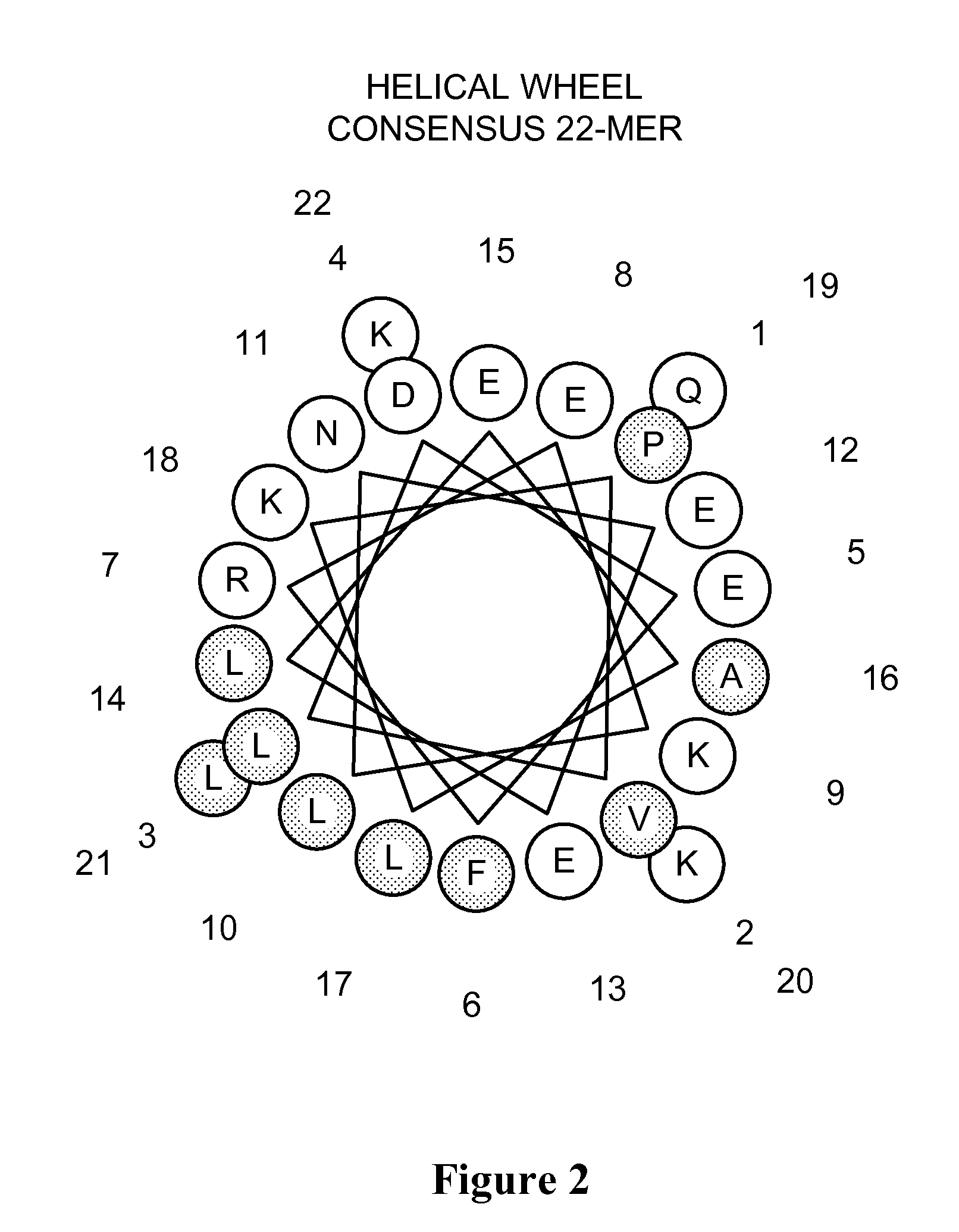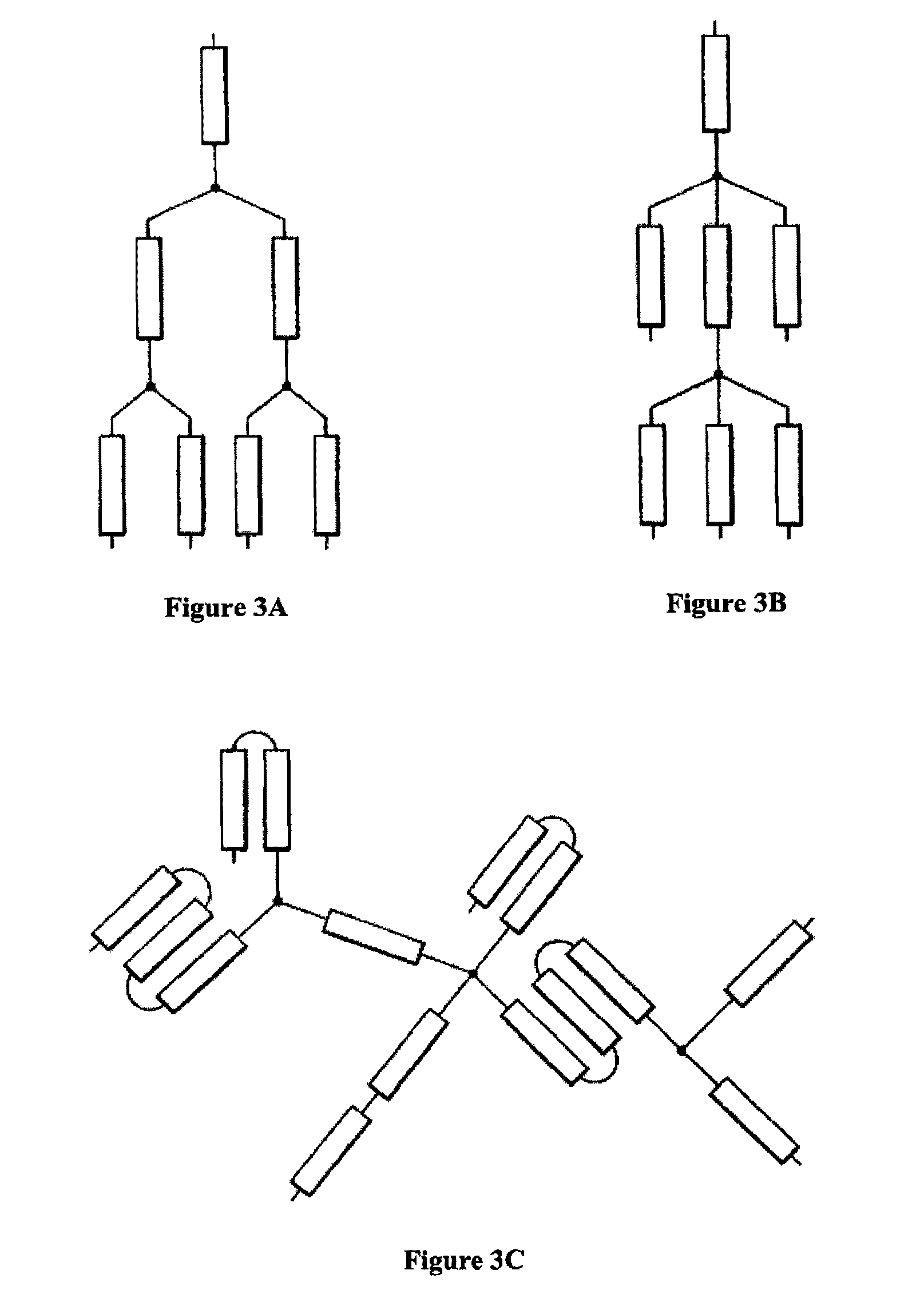Apolipoprotein A-I mimics
a technology of apolipoprotein and mimicry, applied in the field of peptides, can solve the problems of less than ideal as a drug, and the need to overcome significant manufacturing and reproducibility problems
- Summary
- Abstract
- Description
- Claims
- Application Information
AI Technical Summary
Benefits of technology
Problems solved by technology
Method used
Image
Examples
example 1
Synthesis of ApoA-I Mimics
[0687]The ApoA-I Mimics are prepared by solid phase peptide synthesis (SPPS) using Fmoc (9-fluorenylmethyloxycarbonyl) chemistry. The C-terminal residue is covalently bound to a 4-methylbenzhydrylamine (MBHA) resin. The other amino acid residues are then incorporated by repetitive removal of the Fmoc protecting group and coupling of protected amino acid. After solid phase assembling of the peptide, the peptide is cleaved from the resin with trifluoroacetic acid (TFA). The crude peptide is recovered by precipitation and dried. The identity of the crude peptide is confirmed by MS analysis and amino acid analysis.
example 2
Purification of ApoA-I Mimics
[0688]Purification of ApoA-I Mimics prepared according to Example 1 is performed by preparative reverse phase HPLC with a C18 stationary phase (grafted silica, 15 μm particle size, 120 Å pore size) using a water / acetonitrile gradient (with 0.1% TFA counter ion). The eluting fractions are detected by UV absorbance at 220 nm. Each run processes approximately 15 g of crude peptide, with pure fractions being pooled and concentrated on a rotary evaporator. The peptide solution is further purified using the C18 HPLC column used in the first purification step. The peptide solution is then concentrated on a rotary evaporator to remove acetonitrile and freeze-dried.
[0689]Next, the lyophilized peptide powder is re-solubilized in 90% water / 10% acetonitrile and the counter ion is exchanged for acetate through ion exchange chromatography (Dowex resin, 90% water / 10% acetonitrile elution media). The purified peptide with acetate counter ion is filtered through a steril...
example 3
Synthesis of Peptide 16 (SEQ ID NO: 16)
[0690]Peptide 16 (SEQ ID NO: 16) was synthesized on a solid phase support using Fmoc (9-fluorenylmethyloxycarbonyl) chemistry. The C-terminal isonipecotinyl residue was covalently bound to resin via a Wang type linker. Protecting groups used for the amino acids were: t-Butyl group for Glu and Asp, Boc group for Lys, Pbf group for Arg, Trt group for Asn and Gln.
[0691]The solid phase assembling of the peptide was performed manually in a 601 reactor equipped with a fritted disk, a mechanical stifling and nitrogen bubbling. The resin, p-methyl-benzhydrylamine resin (polystyrene-1%-divinylbenzene), was swelled and washed with dichloromethane (DCM) / dimethylformamide (DMF) (95 / 5). Incorporation of the C-terminal residue was achieved by coupling of the C-terminal isonipecotic acid esterified on a MPPA linker (Wang type linker). The coupling reaction was carried out with 1.35 eq of Fmoc-Inp-MPPA-linker, 1.35 eq. of N-hydroxybenzotriazole (HOBt), benzotr...
PUM
| Property | Measurement | Unit |
|---|---|---|
| weight ratio | aaaaa | aaaaa |
| weight ratio | aaaaa | aaaaa |
| weight ratio | aaaaa | aaaaa |
Abstract
Description
Claims
Application Information
 Login to View More
Login to View More - R&D
- Intellectual Property
- Life Sciences
- Materials
- Tech Scout
- Unparalleled Data Quality
- Higher Quality Content
- 60% Fewer Hallucinations
Browse by: Latest US Patents, China's latest patents, Technical Efficacy Thesaurus, Application Domain, Technology Topic, Popular Technical Reports.
© 2025 PatSnap. All rights reserved.Legal|Privacy policy|Modern Slavery Act Transparency Statement|Sitemap|About US| Contact US: help@patsnap.com



